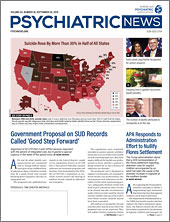Many psychiatrists use or are in the process of converting from paper records to electronic health records (EHRs). When using EHRs, they need to remember that metadata exist behind the words and information that are visible on the computer screen.
Metadata are data that provide details about the information entered into the computer system. For example, when a psychiatrist logs into a patient’s EHR, the EHR system will record and save each piece of data that the psychiatrist enters, including any changes or deletions made to the EHR. Additionally, the system will automatically record the user’s name, the date and time of the record entry, and any other key data the software was built to capture without the user having to manually enter the information. These metadata are typically saved “behind the scenes” on a server or file that users cannot access themselves. This process ensures data integrity so users cannot alter a medical record without a recording of the changes made.
How Can Metadata Impact Litigation?
When there is litigation against a psychiatrist, the integrity of the EHR data is one of the most important aspects to defending a lawsuit.
In “the old days” of paper records, plaintiff attorneys would occasionally attempt to discredit a defendant by uncovering alterations made to a paper record that “looked suspicious.” Today it is much easier for a plaintiff attorney to discover changes to the record by requesting the metadata of the patient’s record and having it analyzed through a health record “audit trail” conducted by an IT specialist. The audit trail is a path that can be followed showing who accessed the system, when it was accessed, and what information was entered or deleted. The use of EHRs makes altering a record without detection much harder because the system is recording everything a user is doing, regardless of whether the user can see all of the data being recorded.
As a result, plaintiff attorneys have been requesting metadata during discovery more frequently when they bring medical malpractice cases against a provider. They do this in hopes of finding something the provider did—after the lawsuit was filed or medical records were requested—to alter, or even cover up, information that was contained or missing from the original version of the medical record.
When a provider “alters” a medical record in any way after the fact, an otherwise defensible case may become one requiring settlement. Also, some medical malpractice policies specifically exclude or significantly limit coverage for a lawsuit once an altered medical record is discovered, leaving the insured defendant financially vulnerable.
What If I Need to Change a Patient’s Record?
Providers facing litigation who have a legitimate reason to change an EHR entry after the fact should consult with their legal counsel or risk management professional for guidance before making any changes to the EHR. Oftentimes, what a provider thinks may be an important update to the record is better served through testimony at deposition or trial, rather than making changes after the fact to the EHR.
If a legal or risk management expert agrees with updating the patient’s record to either correct an error or include an addendum or a late entry, the provider should ensure that the original entry and original date and time stamp are viewable and then include the current date/time of the amended entry as well as the name of the person making the change and the reason(s) for the change. These details will help ensure the integrity of the record and avoid claims of altering evidence after the fact. Remember, metadata will reveal what was changed, by whom, and when.
Providers facing litigation who have a legitimate reason to change an EHR entry after the fact should consult with their legal counsel or risk management professional for guidance before making any changes to the EHR. Oftentimes, what a provider thinks may be an important update to the record is better served through testimony at deposition or trial, rather than making changes after the fact to the EHR.
If a legal or risk management expert agrees with updating the patient’s record to either correct an error or include an addendum or a late entry, the provider should ensure that the original entry and original date and time stamp are viewable and then include the current date/time of the amended entry as well as the name of the person making the change and the reason(s) for the change. These details will help ensure the integrity of the record and avoid claims of altering evidence after the fact. Remember, metadata will reveal what was changed, by whom, and when.
How Can Metadata Defend Me in Litigation?
Just as poor recordkeeping and poor data integrity can hurt you in litigation, keeping thorough, accurate, and timely medical records, supported by the metadata, can assist your defense in documenting your thought process in treating the patient. Remember, detailed recordkeeping and good data integrity go a long way toward successfully defending a lawsuit. ■
This information is provided as a risk management resource for Allied World policyholders and should not be construed as legal or clinical advice. This material may not be reproduced or distributed without the express, written permission of Allied World Assurance Company Holdings, Ltd, a Fairfax company (“Allied World”). Risk management services are provided by or arranged through AWAC Services Company, a member company of Allied World.

